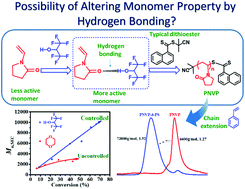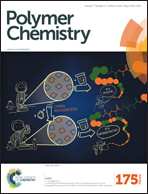RAFT polymerization of N-vinylpyrrolidone mediated by cyanoprop-2-yl-1-dithionaphthalate in the presence of a fluoroalcohol: the possibility of altering monomer properties by hydrogen bonding?†
Abstract
Unlike the more active monomers (MAMs), techniques for the controlled polymerization of less active monomers (LAMs) are still deficient, and special controlled radical polymerization (CRP) techniques or mediators are usually needed. And, the preparation of P(LAM)-b-P(MAM) type block copolymers often required transformation of the CRP mechanism or the chain end group. In this work, the LAM-type monomer N-vinylpyrrolidone (NVP) underwent well-controlled reversible addition–fragmentation chain transfer (RAFT) polymerization with 2-cyanoprop-2-yl-1-dithionaphthalate (CPDN) as the RAFT agent in 1,1,1,3,3,3-hexafluoro-2-propanol (HFIP). According to the classical RAFT rule, CPDN is a good RAFT agent for MAMs, and it cannot provide good control over LAMs. In the current work, the polymerization with HFIP as the solvent offered a higher polymerization rate and much better controllability compared with other solvents, such as dioxane or dimethyl formamide. The reason can be ascribed to the hydrogen bonding interaction between NVP and HFIP as confirmed based on NMR analysis and computer simulation. The hydrogen bonding constant and the length of hydrogen bonding were calculated to be 2.93 L mol−1 and 1.702 Å, respectively. The chain end functionality of the PNVP obtained in HFIP was 75%, much higher than that in dioxane (14%). Upon hydrogen bonding interaction, it was plausibly supposed that NVP showed the transfer tendency from a LAM to a MAM. The subsequent chain extension with styrene or methyl acrylate as the second monomer and PNVP (in HFIP) as the macro-RAFT agent readily produced a P(LAM)-b-P(MAM) like block copolymer. This work illustrated a first example of altering the monomer properties by manipulating the hydrogen bonding interaction as well as providing a straightforward approach for preparing the P(LAM)-b-P(MAM) block copolymer.


 Please wait while we load your content...
Please wait while we load your content...